10 Stunning White Flowers with Yellow Centers
Discover 10 stunning white Flowers with yellow centers that will brighten any garden. Learn about their unique features, care tips and how to incorporate them into your landscape.
Flowers come in all shapes, sizes and colors. Some of the most eye-catching are white flowers with yellow centers. These blooms stand out in any garden with their bright, cheerful appearance. Let’s explore 10 beautiful examples of these flowers that you can grow in your own backyard.
1. Shasta Daisy (Leucanthemum x superbum)
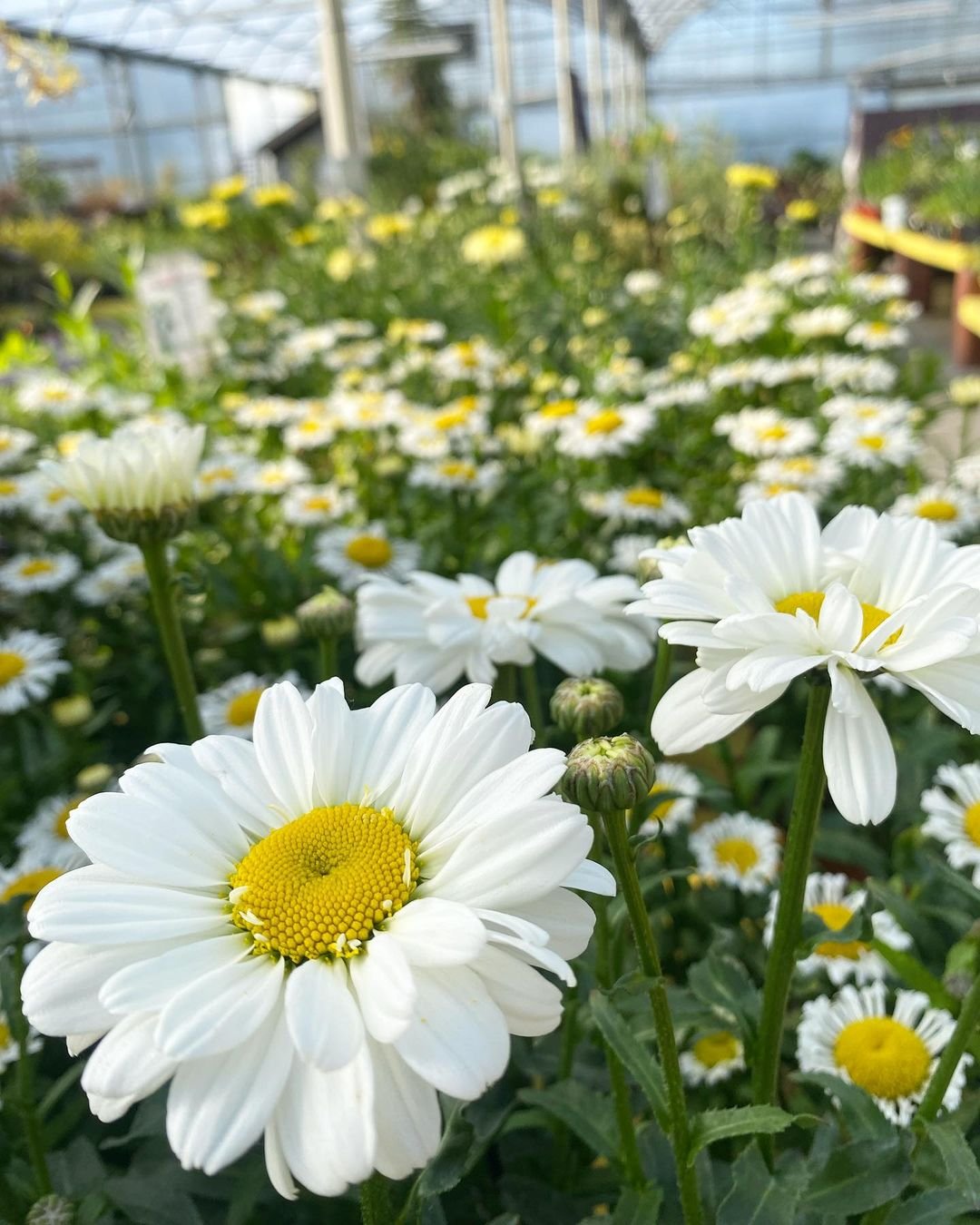
Here’s a short information chart about the Shasta Daisy (Leucanthemum x superbum):
| Feature | Information |
|---|---|
| Scientific Name | Leucanthemum x superbum |
| Common Name | Shasta Daisy |
| Family | Asteraceae |
| Origin | Garden hybrid; originated in the 19th century in the United States |
| Description | Herbaceous perennial known for its large, white, daisy-like flowers with yellow centers |
| Size | Typically grows 1-3 feet tall (30-90 cm) |
| Blooming Period | Late spring to early summer, sometimes into fall |
| Sun Requirements | Full sun |
| Soil Requirements | Well-draining soil |
| Watering Needs | Regular watering; prefers evenly moist soil |
| Hardiness Zones | Zones 5-9 (USDA) |
| Maintenance | Deadheading spent blooms encourages more flowering; divide clumps every few years |
| Special Features | Attracts pollinators like bees and butterflies; good cut flowers |
| Uses | Borders, containers, cutting gardens, cottage gardens |
The Shasta daisy is a classic flower that many people love. It has big white petals around a sunny yellow center. These flowers grow in clumps and can reach up to 3 feet tall. They bloom from early summer to fall, bringing long-lasting color to your garden.
Shasta daisies are easy to grow and care for. They like full sun and well-drained soil. You can plant them in spring or fall. Once established, they don’t need much water. These flowers attract butterflies and make great cut flowers for bouquets.
Fun fact: The Shasta daisy was created by Luther Burbank, a famous plant breeder. He named it after Mount Shasta in California because its white petals reminded him of snow.
2. Oxeye Daisy (Leucanthemum vulgare)
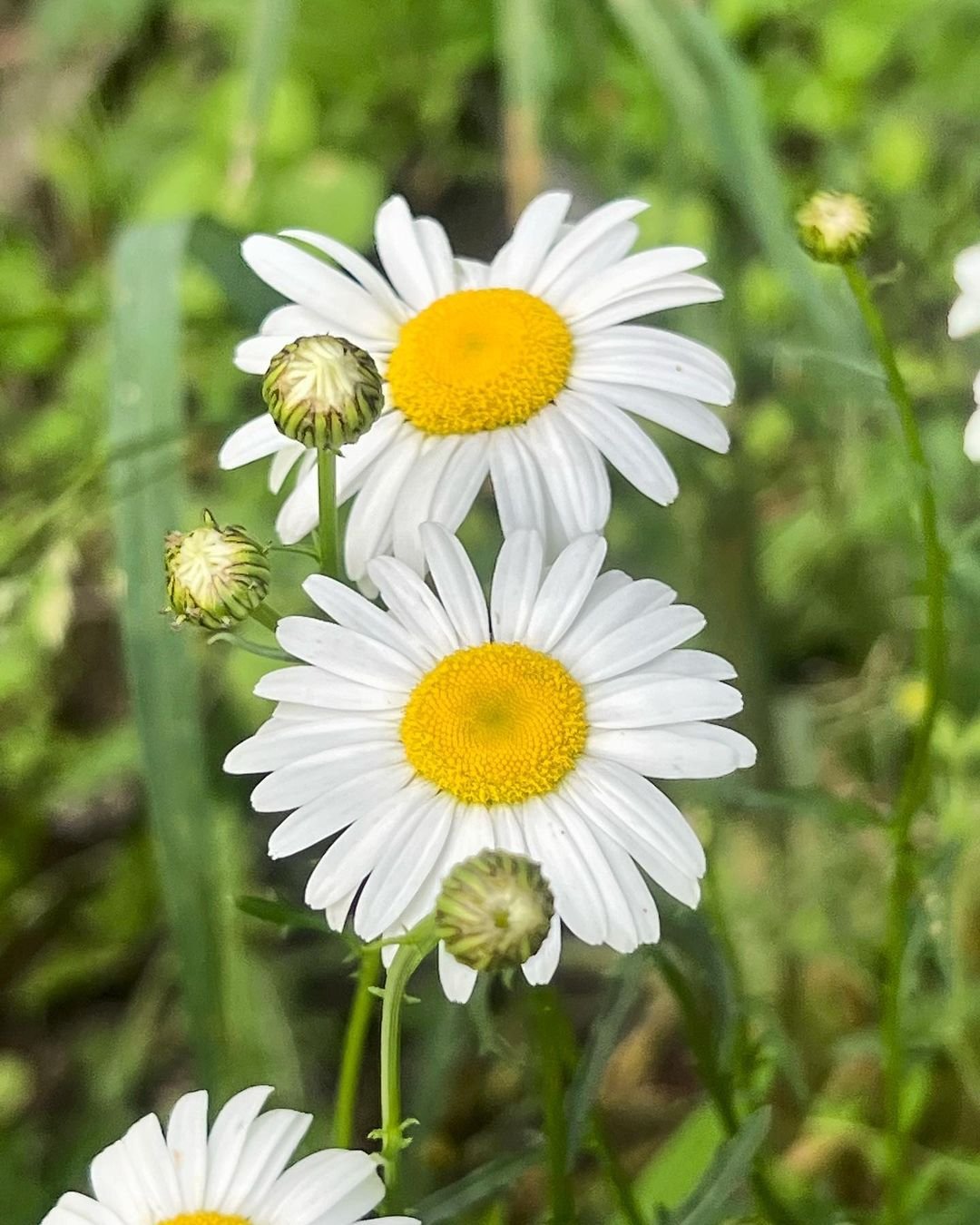
Here’s a short information chart about the Oxeye Daisy (Leucanthemum vulgare):
| Feature | Information |
|---|---|
| Scientific Name | Leucanthemum vulgare |
| Common Name | Oxeye Daisy, Marguerite Daisy |
| Family | Asteraceae |
| Origin | Native to Europe and Asia, naturalized in North America |
| Description | Herbaceous perennial with white daisy-like flowers and yellow centers |
| Size | Typically grows 1-3 feet tall (30-90 cm) |
| Blooming Period | Late spring to late summer |
| Sun Requirements | Full sun |
| Soil Requirements | Prefers well-draining soil but tolerant of various soil types |
| Watering Needs | Moderate; drought-tolerant once established |
| Hardiness Zones | Zones 3-9 (USDA) |
| Maintenance | Deadhead spent flowers to prolong blooming; may self-seed prolifically |
| Special Features | Attracts pollinators such as bees and butterflies; deer-resistant |
| Uses | Wildflower gardens, meadows, naturalized areas |
The oxeye daisy looks a lot like its cousin, the Shasta daisy. It has white petals and a yellow center, but it’s a bit smaller. These flowers grow wild in many parts of North America and Europe. They’re tough plants that can grow in poor soil and don’t need much care.
Oxeye daisies bloom from late spring to early fall. They spread easily, which can be good or bad depending on your garden goals. Some places consider them weeds because they can take over quickly.
These flowers are great for wildflower gardens or meadows. They attract bees and other pollinators. If you want to grow oxeye daisies, make sure they’re not invasive in your area first.
3. White Coneflower (Echinacea purpurea ‘White Swan’)
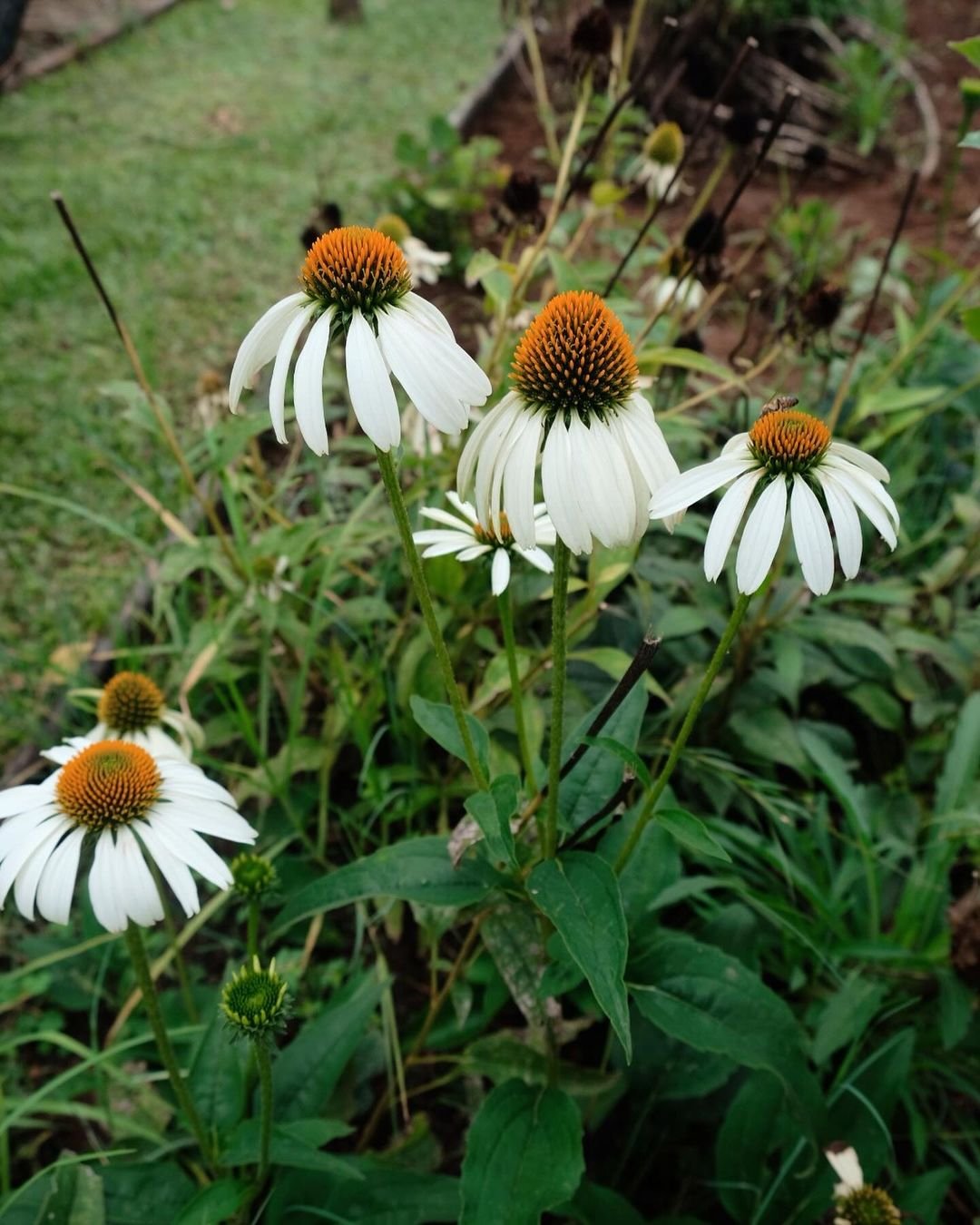
Here’s a concise information chart about the White Coneflower (Echinacea purpurea ‘White Swan’):
| Feature | Information |
|---|---|
| Scientific Name | Echinacea purpurea ‘White Swan’ |
| Common Name | White Coneflower |
| Family | Asteraceae (Compositae) |
| Origin | Cultivar derived from North America, specifically the Great Plains |
| Description | Herbaceous perennial known for its large, white, cone-shaped flowers |
| Size | Typically grows 2-3 feet tall (60-90 cm) |
| Blooming Period | Mid-summer to early fall |
| Sun Requirements | Full sun |
| Soil Requirements | Well-drained soil; tolerant of dry and poor soils |
| Watering Needs | Drought tolerant once established; regular watering in dry periods |
| Hardiness Zones | Zones 3-9 (USDA) |
| Maintenance | Deadhead spent blooms to encourage more flowering; divide clumps every few years |
| Special Features | Attracts pollinators like bees and butterflies; excellent cut flower |
| Uses | Borders, wildflower gardens, cottage gardens, pollinator gardens |
White coneflowers are a unique twist on the popular purple coneflower. They have drooping white petals and a large, spiky yellow-orange center. These flowers can grow up to 3 feet tall and bloom from midsummer to fall.
Coneflowers are native to North America and are very hardy. They can handle heat, drought, and poor soil. Plant them in full sun for the best blooms. These flowers are great for attracting butterflies and birds. The seeds in the center cone are a favorite food for goldfinches.
White coneflowers are not only pretty but also useful. Some people use echinacea as an herbal remedy to boost the immune system. However, always talk to a doctor before using any herbal medicines.
4. Chamomile (Matricaria chamomilla)
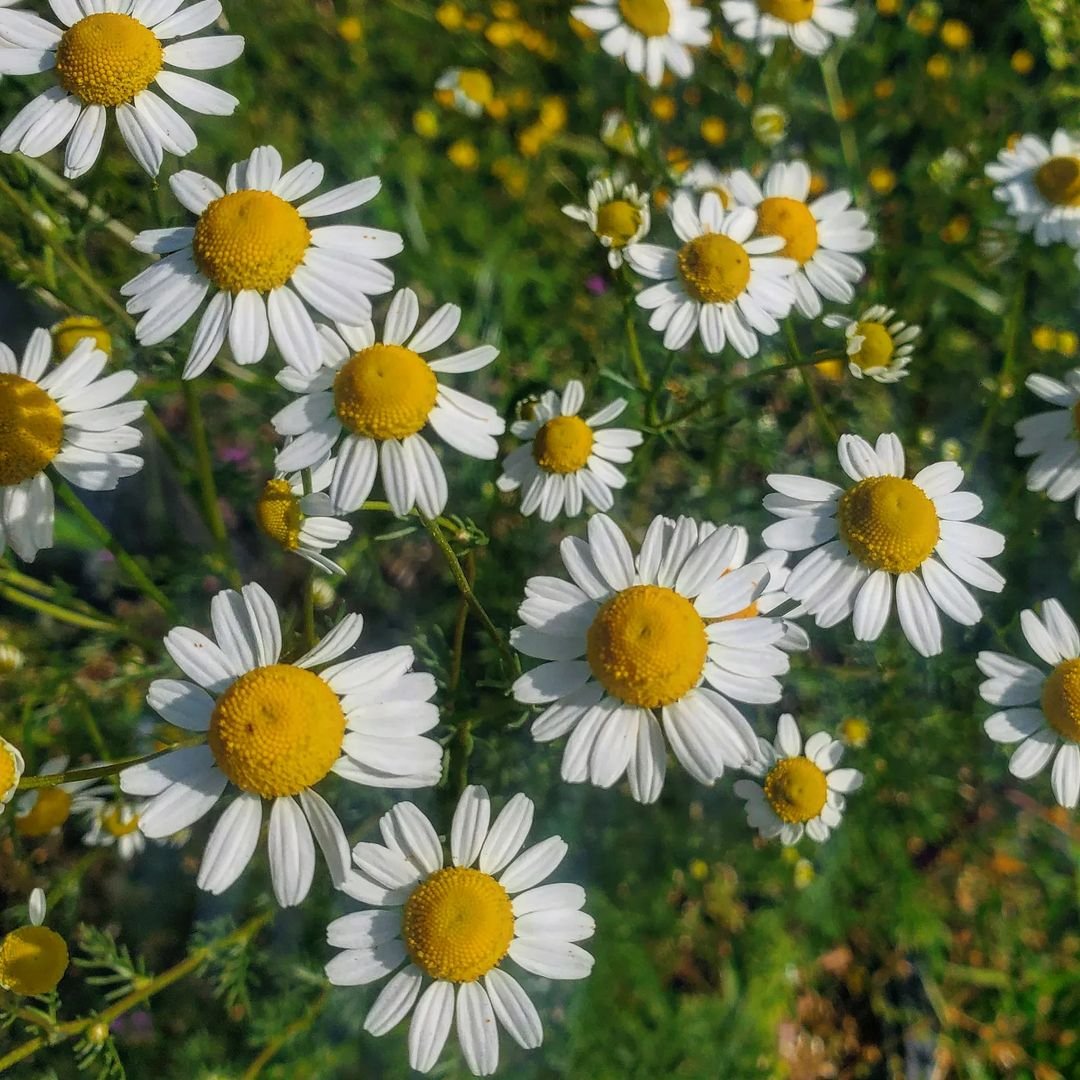
Here’s a short information chart about Chamomile (Matricaria chamomilla):
| Feature | Information |
|---|---|
| Scientific Name | Matricaria chamomilla (also known as Matricaria recutita) |
| Common Name | Chamomile |
| Family | Asteraceae |
| Origin | Native to Europe and western Asia, naturalized in other regions |
| Description | Annual herbaceous plant with finely divided leaves and small, daisy-like flowers |
| Size | Typically grows up to 1-2 feet tall (30-60 cm) |
| Blooming Period | Late spring to summer |
| Sun Requirements | Full sun |
| Soil Requirements | Well-drained, sandy soil |
| Watering Needs | Regular watering; prefers evenly moist soil |
| Hardiness Zones | Zones 3-9 (USDA) |
| Maintenance | Regular harvesting of flowers for medicinal use; self-seeds readily |
| Special Features | Fragrant flowers used in herbal teas and aromatherapy; attracts beneficial insects |
| Uses | Medicinal herb for calming teas, topical applications; companion plant in gardens |
Chamomile is a sweet-smelling flower that looks like a tiny daisy. It has small white petals and a yellow center. The plants grow about 2 feet tall and bloom from early summer to fall.
There are two main types of chamomile: German and Roman. German chamomile is more common in gardens. It’s an annual plant, which means you need to replant it each year. Roman chamomile is a low-growing perennial that makes a nice ground cover.
Chamomile flowers are famous for making tea. The tea has a mild, apple-like flavor and is often used to help people relax or sleep better. These flowers are also great for attracting beneficial insects to your garden.
5. White Zinnia (Zinnia elegans)
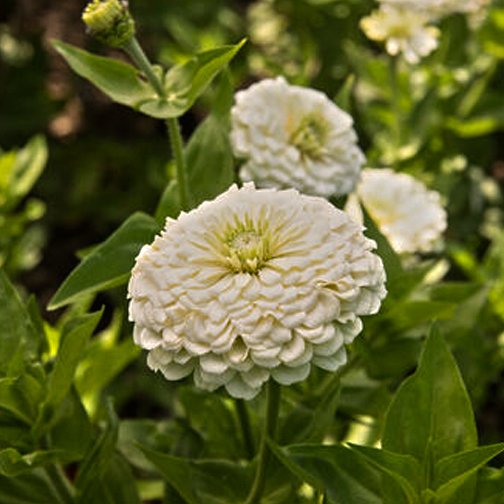
Here’s a concise information chart about the White Zinnia (Zinnia elegans):
| Feature | Information |
|---|---|
| Scientific Name | Zinnia elegans |
| Common Name | White Zinnia |
| Family | Asteraceae |
| Origin | Mexico, Central America |
| Description | Annual flowering plant known for its solitary, daisy-like flowers in various colors, including white |
| Size | Typically grows 1-3 feet tall (30-90 cm) |
| Blooming Period | Summer to frost |
| Sun Requirements | Full sun |
| Soil Requirements | Well-drained soil |
| Watering Needs | Regular watering; drought-tolerant once established |
| Hardiness Zones | Zones 2-11 (USDA) |
| Maintenance | Deadhead spent flowers to prolong blooming; may self-sow |
| Special Features | Attracts butterflies and beneficial insects; good cut flower |
| Uses | Borders, containers, cutting gardens, mass plantings |
White zinnias are cheerful flowers that come in many shapes and sizes. They have layers of white petals around a yellow center. Some look like daisies, while others are more like pom-poms. Zinnias can grow from 6 inches to 4 feet tall, depending on the variety.
These flowers are easy to grow from seeds. Plant them in spring after the last frost. They like full sun and bloom from summer until the first fall frost. Zinnias are great for cutting gardens because they last a long time in vases.
Zinnias attract butterflies and hummingbirds. They come in many colors, but white zinnias with yellow centers are especially striking. These flowers are also good for beginner gardeners because they’re hard to kill.
6. White Cosmos (Cosmos bipinnatus)
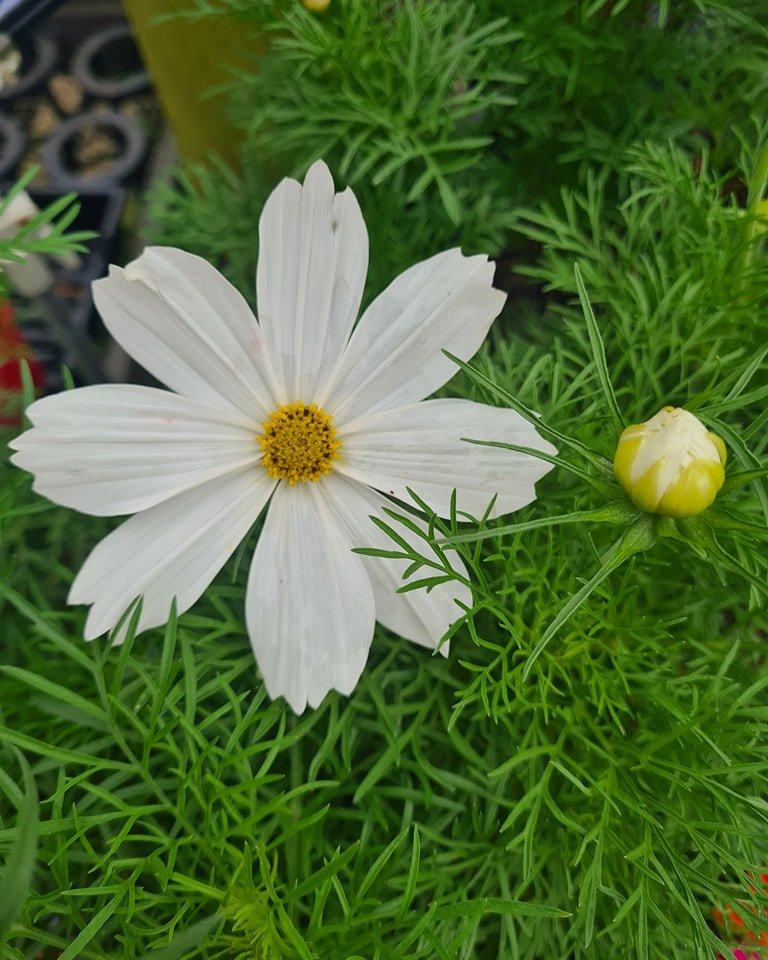
Here’s a concise information chart about White Cosmos (Cosmos bipinnatus):
| Feature | Information |
|---|---|
| Scientific Name | Cosmos bipinnatus |
| Common Name | White Cosmos |
| Family | Asteraceae |
| Origin | Native to Mexico |
| Description | Annual flowering plant with delicate, feathery foliage and white, daisy-like flowers |
| Size | Typically grows 2-4 feet tall (60-120 cm) |
| Blooming Period | Summer to fall |
| Sun Requirements | Full sun |
| Soil Requirements | Well-drained soil; tolerant of poor soil conditions |
| Watering Needs | Moderate; drought-tolerant once established |
| Hardiness Zones | Zones 2-11 (USDA) |
| Maintenance | Deadhead spent flowers to promote continuous blooming; self-sows easily |
| Special Features | Attracts pollinators like bees and butterflies; good for cutting gardens |
| Uses | Borders, containers, cottage gardens, wildflower meadows |
White cosmos are delicate-looking flowers with feathery leaves. They have white petals and bright yellow centers. These flowers grow on tall, slender stems and can reach up to 6 feet high. They bloom from summer to fall, adding height and airiness to gardens.
Cosmos are easy to grow from seeds. They like full sun and can tolerate poor soil. In fact, they often bloom better in soil that’s not too rich. These flowers are great for cottage gardens or wildflower meadows. They self-seed easily, so you might get new plants each year without replanting.
Bees and butterflies love cosmos flowers. They’re also great for cutting gardens. The more you cut them, the more they bloom. White cosmos look beautiful mixed with other colors of cosmos or different types of flowers.
7. White Gaillardia (Gaillardia x grandiflora ‘Arizona Apricot’)
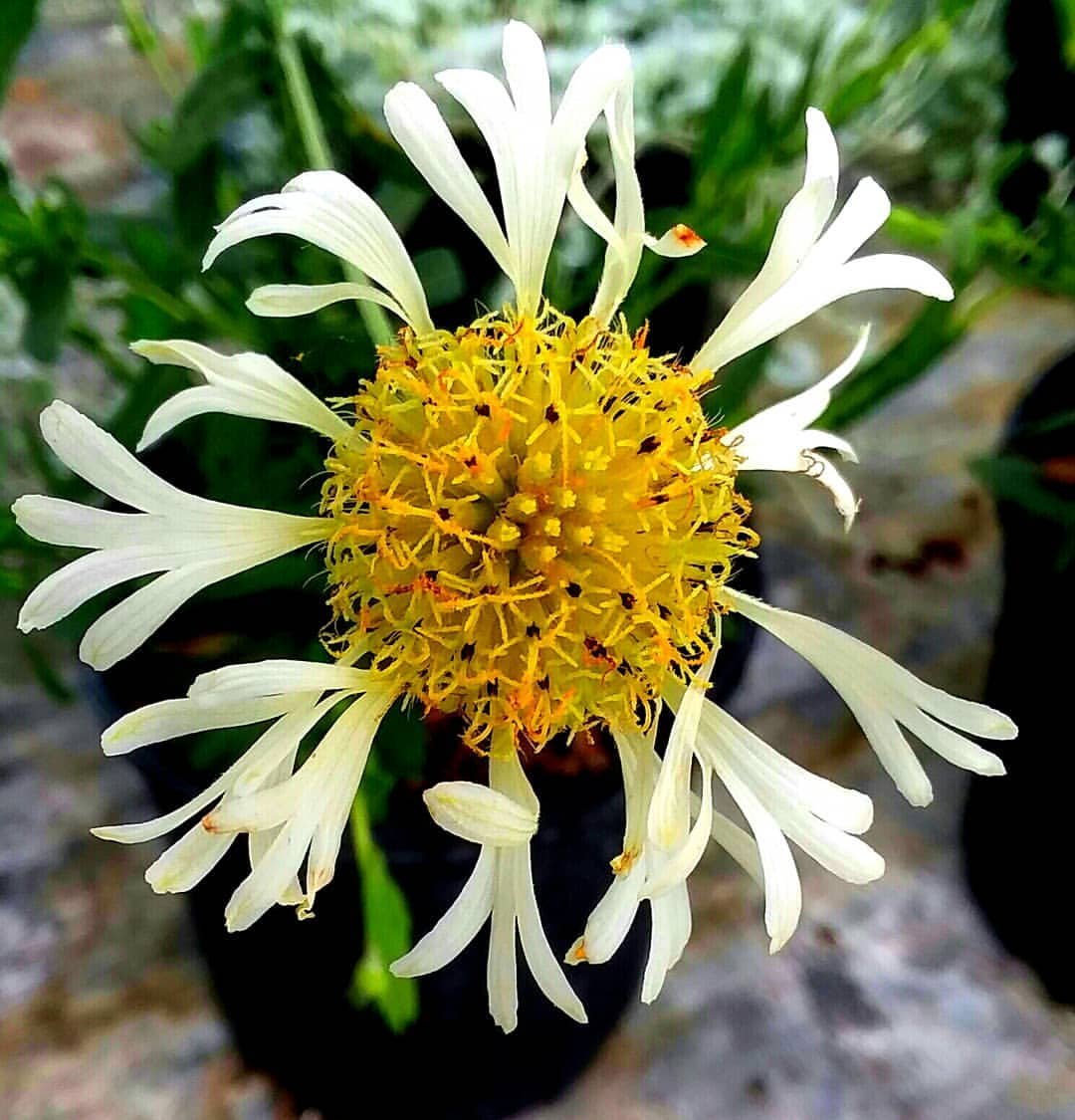
Here’s a concise information chart about White Gaillardia (Gaillardia x grandflora ‘Arizona Apricot’):
| Feature | Information |
|---|---|
| Scientific Name | Gaillardia x grandflora ‘Arizona Apricot’ |
| Common Name | White Gaillardia |
| Family | Asteraceae |
| Origin | Garden hybrid, derived from North American native species |
| Description | Perennial flowering plant with daisy-like flowers in shades of white and apricot |
| Size | Typically grows 1-2 feet tall (30-60 cm) |
| Blooming Period | Summer to fall |
| Sun Requirements | Full sun |
| Soil Requirements | Well-drained soil |
| Watering Needs | Moderate; drought-tolerant once established |
| Hardiness Zones | Zones 3-10 (USDA) |
| Maintenance | Deadhead spent flowers to encourage more blooming; divide every few years |
| Special Features | Attracts pollinators like bees and butterflies; deer resistant |
| Uses | Borders, wildflower gardens, rock gardens, xeriscaping |
White gaillardia, also known as blanket flower, is a tough and colorful plant. The ‘Arizona Apricot’ variety has white petals with yellow tips and a big yellow center. These flowers bloom all summer long, even in hot and dry conditions.
Gaillardia are native to North America and are very hardy. They like full sun and well-drained soil. Once established, they don’t need much water. These flowers attract butterflies and are resistant to deer and rabbits.
The ‘Arizona Apricot’ variety grows about 12 inches tall and wide, making it great for borders or containers. It’s a perennial in many areas, coming back year after year. The cheery flowers brighten up any garden with their long-lasting blooms.
8. White Hellebore (Helleborus niger)
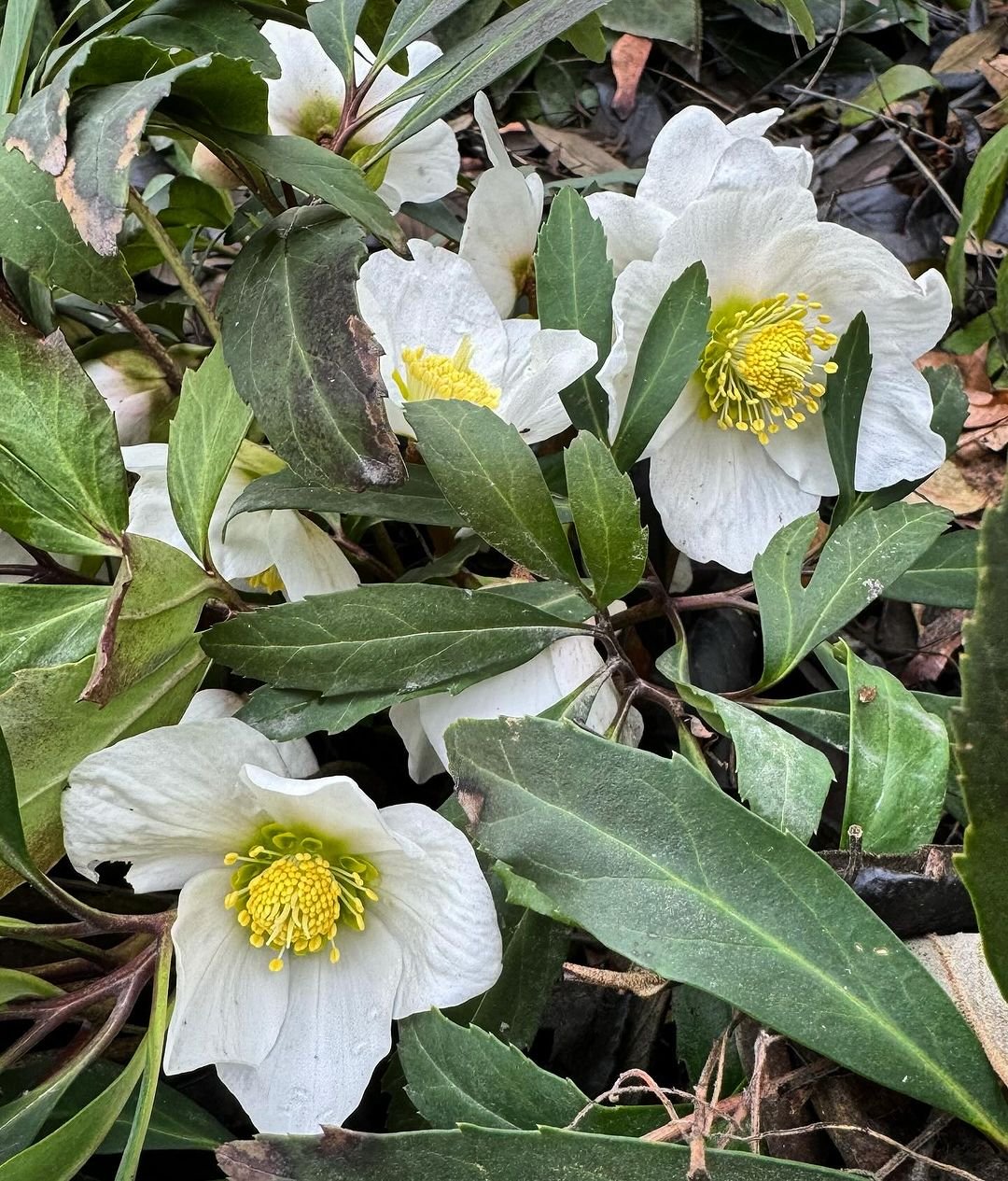
Here’s a concise information chart about White Hellebore (Helleborus niger):
| Feature | Information |
|---|---|
| Scientific Name | Helleborus niger |
| Common Name | White Hellebore, Christmas Rose |
| Family | Ranunculaceae |
| Origin | Native to mountainous regions of Europe, especially the Alps |
| Description | Perennial herbaceous plant with leathery, dark green leaves and white or pale pink, bowl-shaped flowers |
| Size | Typically grows 12-18 inches tall (30-45 cm) |
| Blooming Period | Late winter to early spring |
| Sun Requirements | Partial shade to full shade |
| Soil Requirements | Rich, well-drained soil |
| Watering Needs | Regular watering; prefers evenly moist soil |
| Hardiness Zones | Zones 4-9 (USDA) |
| Maintenance | Mulch around the base to protect from extreme temperatures; cut back foliage in late winter before new growth emerges |
| Special Features | Early bloomer in late winter, often around Christmas; deer and rabbit resistant |
| Uses | Shade gardens, woodland gardens, borders, underplanting for trees and shrubs |
White hellebores, also called Christmas roses, are unique flowers that bloom in late winter or early spring. They have large, cup-shaped white flowers with yellow centers. These plants are evergreen, meaning they keep their leaves all year.
Hellebores like partial shade and rich, well-drained soil. They’re tough plants that can handle cold weather. In fact, they often bloom when there’s still snow on the ground. These flowers are toxic, so deer and rabbits don’t eat them.
White hellebores are great for shade gardens or woodland areas. They look beautiful planted in groups. The flowers last a long time, both on the plant and when cut for bouquets. These plants are low-maintenance once established and can live for many years.
9. White Anemone (Anemone coronaria)
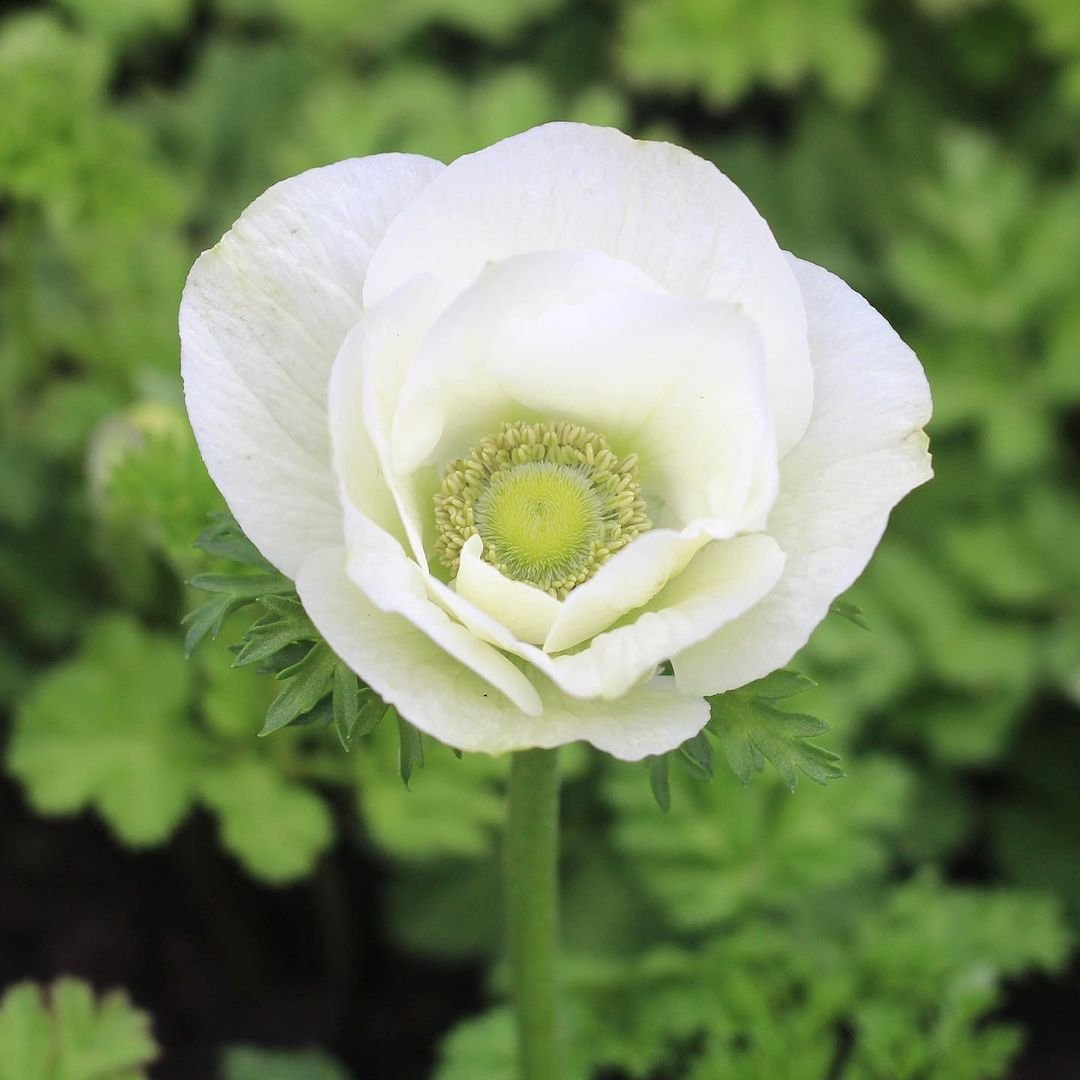
Here’s a concise information chart about White Anemone (Anemone coronaria):
| Feature | Information |
|---|---|
| Scientific Name | Anemone coronaria |
| Common Name | White Anemone |
| Family | Ranunculaceae |
| Origin | Native to the Mediterranean region |
| Description | Herbaceous perennial with deeply lobed leaves and large, single, white flowers |
| Size | Typically grows 12-18 inches tall (30-45 cm) |
| Blooming Period | Late winter to spring |
| Sun Requirements | Full sun to partial shade |
| Soil Requirements | Well-drained soil |
| Watering Needs | Moderate; keep soil evenly moist during active growth |
| Hardiness Zones | Zones 7-10 (USDA) |
| Maintenance | Deadhead spent flowers to prolong blooming; divide clumps every few years |
| Special Features | Attractive to pollinators like bees and butterflies; good cut flower |
| Uses | Borders, rock gardens, containers, cut flower gardens |
White anemones are delicate-looking flowers with papery petals. They have a ring of white petals around a green center that turns yellow as it matures. These flowers grow on thin stems and can reach about 18 inches tall.
Anemones bloom in spring or fall, depending on the type. They like full sun or partial shade and well-drained soil. These flowers grow from bulb-like structures called corms. Plant them in fall for spring blooms, or in spring for fall blooms.
White anemones are popular in cottage gardens and cutting gardens. They have a wild, natural look that pairs well with other spring flowers like tulips and daffodils. In Greek, anemone means “daughter of the wind” because the flowers seem to dance in the breeze.
10. White Ranunculus (Ranunculus asiaticus)
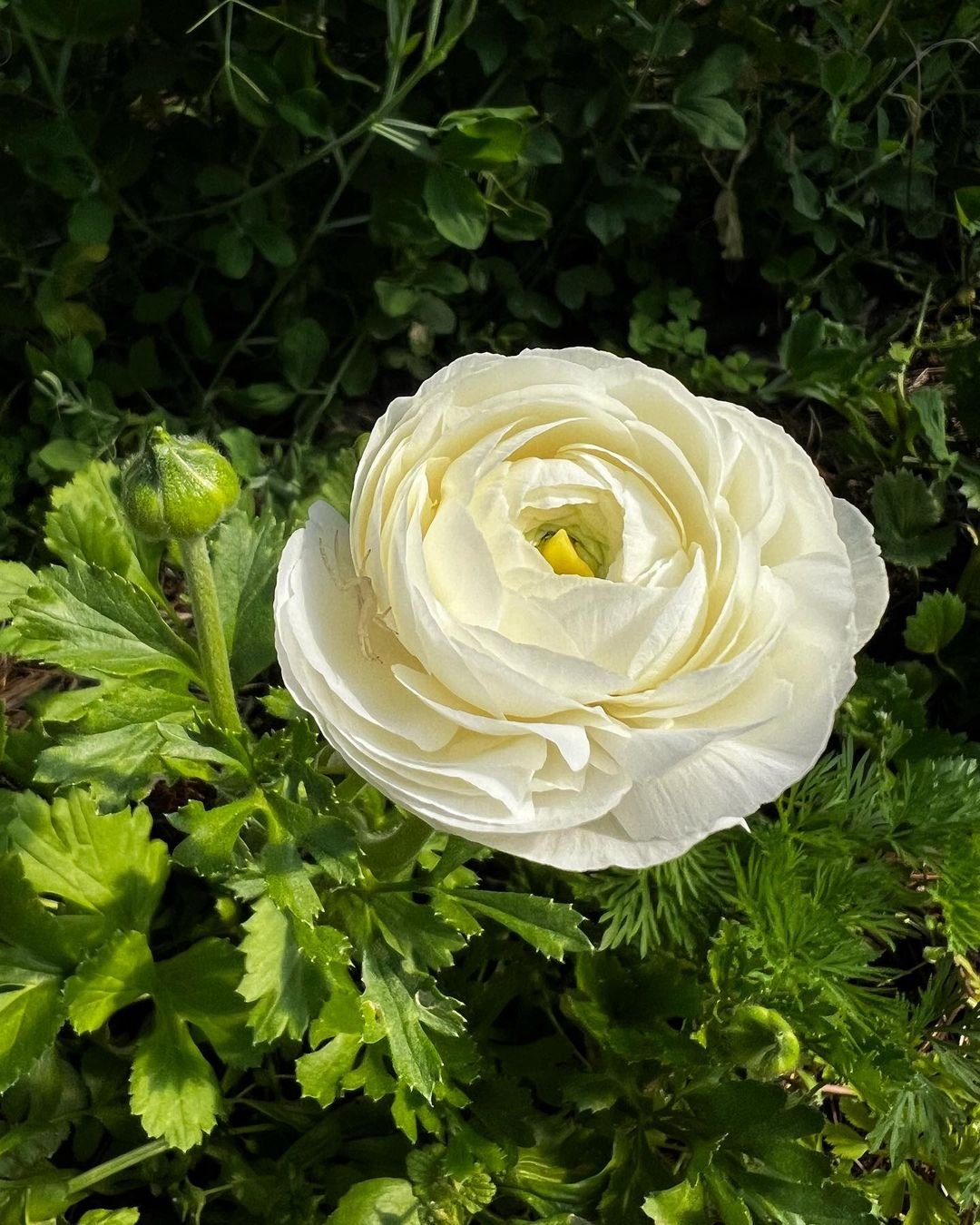
Here’s a concise information chart about White Ranunculus (Ranunculus asiaticus):
| Feature | Information |
|---|---|
| Scientific Name | Ranunculus asiaticus |
| Common Name | White Ranunculus |
| Family | Ranunculaceae |
| Origin | Mediterranean region |
| Description | Herbaceous perennial with glossy, dark green leaves and large, white, rose-like flowers |
| Size | Typically grows 12-18 inches tall (30-45 cm) |
| Blooming Period | Late spring to early summer |
| Sun Requirements | Full sun to partial shade |
| Soil Requirements | Well-drained, fertile soil |
| Watering Needs | Regular watering; keep soil evenly moist during active growth |
| Hardiness Zones | Zones 8-11 (USDA) |
| Maintenance | Deadhead spent flowers to promote continuous blooming; lift and divide bulbs every few years |
| Special Features | Excellent cut flower; deer and rabbit resistant |
| Uses | Borders, containers, cutting gardens, cottage gardens |
White ranunculus, also known as Persian buttercups, are stunning flowers with layers of delicate petals. They have a rose-like shape with a yellow center. These flowers come in many colors, but white ones are especially elegant.
Ranunculus grow from corms, like anemones. Plant them in fall or early spring for blooms in late spring or early summer. They like full sun and well-drained soil. These flowers are popular for weddings and special events because of their beautiful shape.
White ranunculus look great in gardens or containers. They make excellent cut flowers, lasting up to two weeks in a vase. These plants are not very hardy, so in cold areas, you’ll need to dig up the corms and store them inside over winter.
White flowers with yellow centers bring a clean, fresh look to any garden. They stand out against green foliage and pair well with flowers of all colors. From the classic Shasta daisy to the elegant ranunculus, there’s a white and yellow flower for every garden style.
When planning your garden, think about bloom times. By choosing flowers that bloom at different times, you can have white and yellow blooms from early spring to late fall. Also consider the height and growing conditions of each plant to make sure they’ll thrive in your garden.
Remember, most of these flowers attract pollinators like bees and butterflies. By planting them, you’re not only making your garden beautiful but also helping local ecosystems. Whether you’re a beginner or an experienced gardener, these stunning white flowers with yellow centers are sure to bring joy to your outdoor space.
Happy gardening!

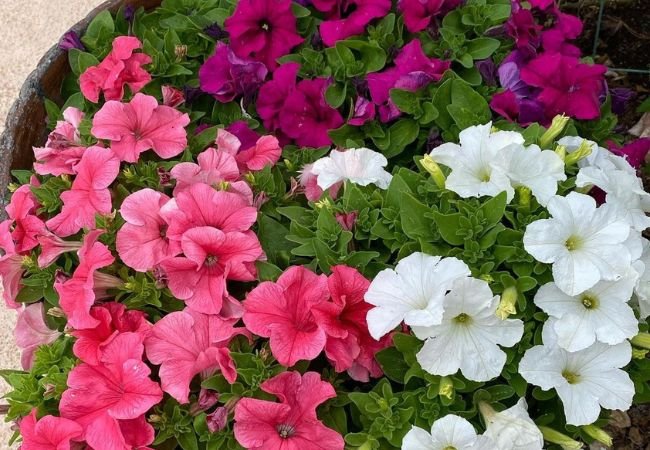
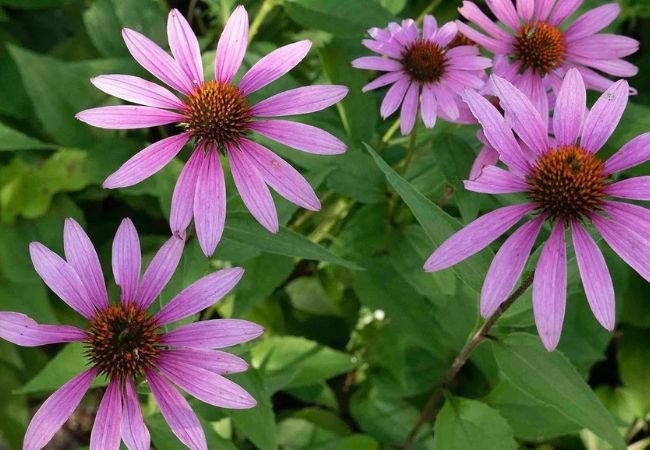
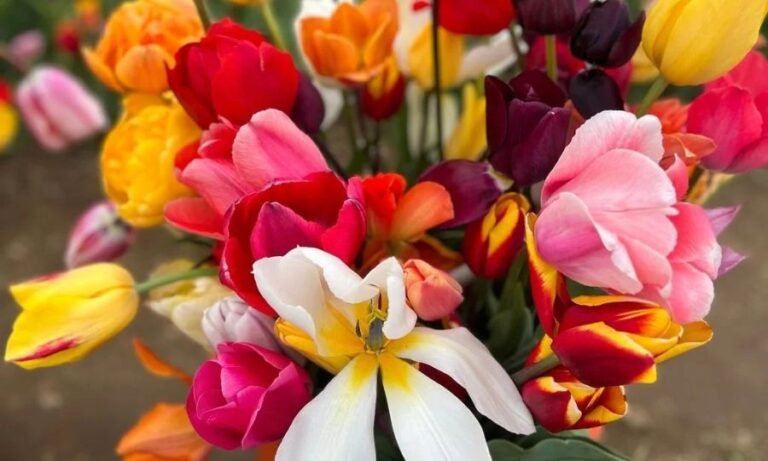
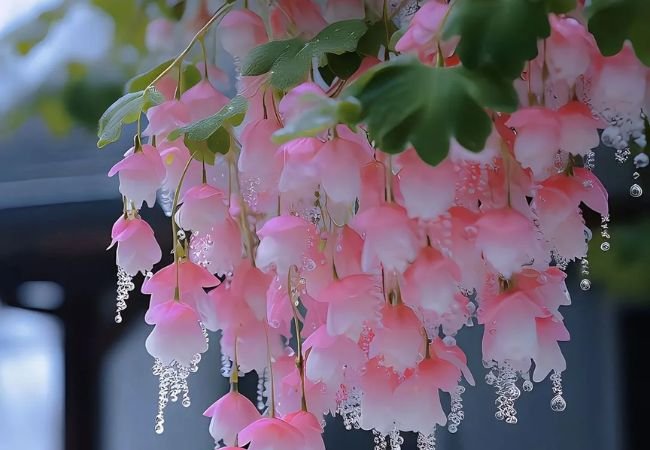
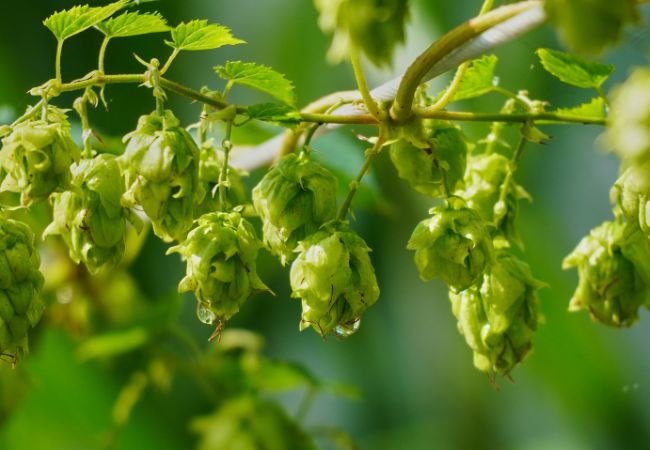
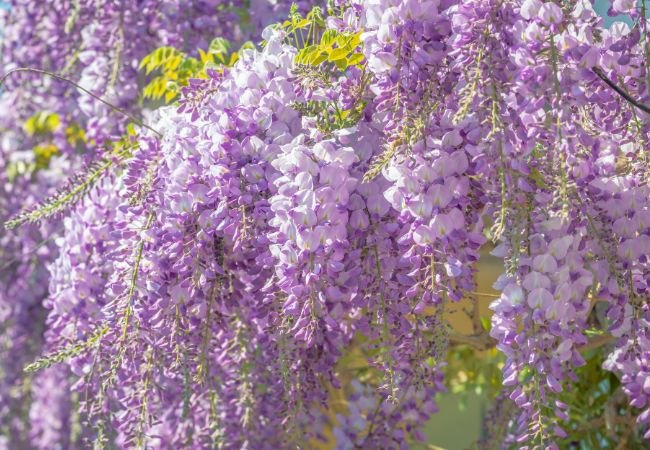
6 Comments